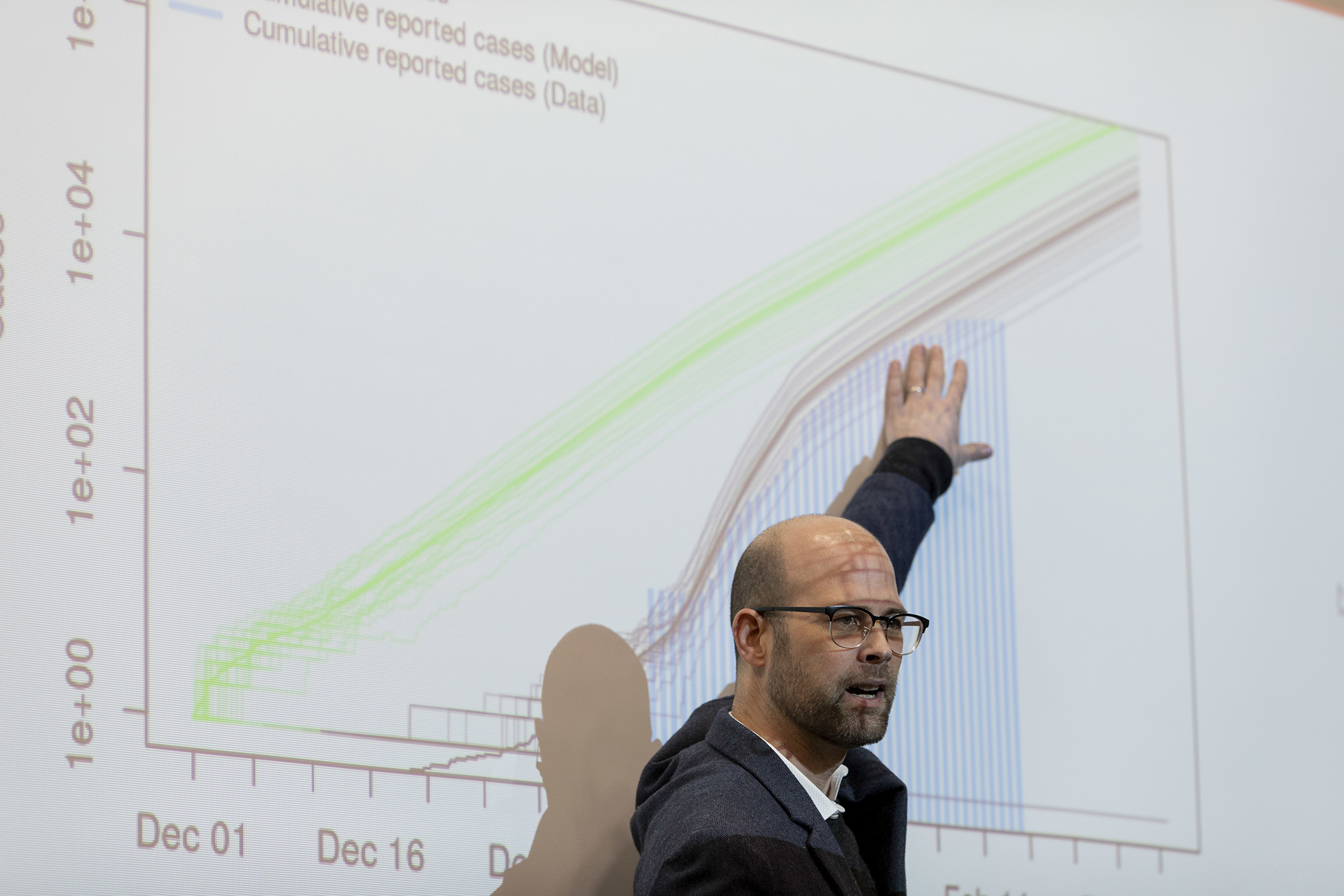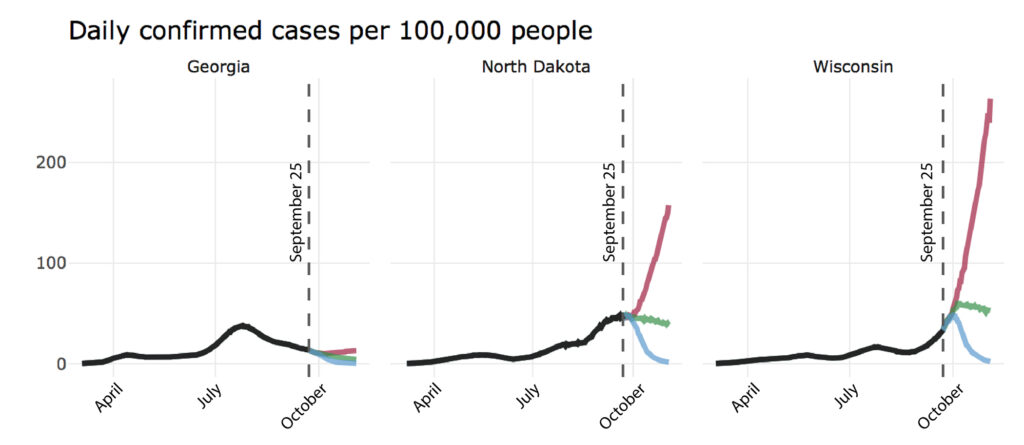A new model posted by the University of Georgia’s Center for the Ecology of Infectious Diseases shows that the pandemic is not slowing down in the United States.
Unlike other COVID-19 mathematical models, the CEID’s model ties together three social distancing scenarios and hard-to-measure interventions like hand washing and wearing a face covering to project relative transmission strength, infections, cases and deaths six weeks into the future in all 50 states.
The model shows that decreased mobility and the use of intervention methods, such as wearing a face covering, is keeping the pandemic from markedly increasing in most of the country.
John Drake, Distinguished Research Professor of Ecology and Director of the Center for the Ecology of Infectious Diseases, is concerned that this may give people a false sense of security and that the risk that COVID-19 still poses is not adequately understood.
“I believe that most persons don’t appreciate how serious the situation really is,” he said. “In Georgia, for example, at the end of July, there were 38 new daily cases per 100,000, and now in mid-September, that number has dropped to under 15 new cases per 100,000 persons. This is the trajectory we want to be on. We cannot afford to let our guard down and lose these hard fought gains.”
If this happens, the pandemic will not be under control in Georgia heading into winter.
Modeling shows that some states are projected to see the number of daily new cases per 100,000 increase. Identified as “hot zone” states, Missouri, North Dakota, Oklahoma, South Dakota, Utah, Wisconsin and Wyoming are at a COVID-19 junction, with each state seeing more than 15 new daily cases per 100,000 persons under current mobility scenarios.
South Dakota has experienced a jump in COVID-19 cases, possibly due to the Sturgis motorcycle rally. Even under current social distancing behaviors, the number of new cases per 100,000 is expected to increase from 33 to 36 by late October. If movement returns to a pre-pandemic level, the number may increase to 54 new daily cases per 100,000.
Two of the largest projected increases in daily new cases per 100,000 persons are forecast to occur in Utah and Wisconsin. In mid-September, each state reported above 20 cases per 100,000 per day. However, even under current mobility, the number of new daily cases is projected to increase above 37 cases per 100,000 per day by late-October. If normal mobility is adopted, daily new cases per 100,000 may increase above 90 in Utah, and above 190 in Wisconsin.

“The potential of a four-to nine-fold rise in daily new cases per 100,000 in six weeks is extremely concerning,” Drake said.
“Nationally, more than 200,000 people have died from COVID-19. We must continue to encourage every person to practice social distancing and to wear face coverings to keep deaths from substantially rising,” he said.
The 50-state model uses three mobility scenarios for each state: pre-COVID-19 “baseline” mobility (e.g. 100% mobility); current or “status quo” mobility that is different in each state (status quo mobility is a percent decrease from normal mobility); and shelter-in-place mobility (i.e. 30% of baseline mobility; the level of mobility that occurred in New York City during the March 20 to April 29 shelter-in-place order to slow SARS-CoV-2 virus transmission).
The model’s red, green, and blue color-coded mobility projection trends visually communicate how our behaviors have a direct effect upon the pandemic. The number of projected new daily cases per 100,000 persons in Wisconsin is a good example. Returning to pre-pandemic patterns of movement and interaction, the red slope results in an exponentially increasing number of daily cases per 100,000 persons, compared to the almost opposite shelter-in-place blue mobility forecast. Maintaining current “status-quo” social distancing behaviors, the green line, projects a slight downward trend in daily cases per 100,000 persons.
Andreas Handel, associate professor of epidemiology and biostatistics in the UGA College of Public Health, who worked with Drake to develop the model, said that UGA’s results are consistent with findings from many other models developed independently by other groups.
“The findings emphasize the importance of continued vigilance to keep transmission low. We must pay attention to our socializing behaviors, and we absolutely must practice good hygiene to drive cases down further,” he said. ”Our model’s projections are subject to change dependent upon how people protect themselves from the possibility of infection.”
To determine mobility habits in each state, researchers used anonymously aggregated mobile phone app data. The number of confirmed cases and deaths are collected daily from clinical outcome reports. A mathematical model was fit to the movement data and reported cases and deaths, meaning the model was tuned until it could reproduce known case data. The model was then used to project cases, deaths and infections into the future.
The model’s interactive visualization tool allows users to select mobility scenarios, prediction interval, daily or cumulative numbers, and absolute or scaled values. It is designed so that when an individual graph is toggled, the date and number of cases, deaths, infected persons and relative transmission strength (defined as ease of spread between persons) is shown.
In addition to Drake and Handel, other University of Georgia researchers who worked on the 50-state model include Eric Marty, Eamon O’Dea, Tierney O’Sullivan, William Norfolk and Andrew Tredennick.
The CEID has many other faculty, staff, and graduate students in the Odum School of Ecology and the Colleges of Public Health and Veterinary Medicine. Collectively, they are working on over 30 COVID-19 modeling projects, including the COVID-19 Portal. The portal was recently updated to report SARS-CoV-2 wastewater surveillance monitoring in Athens and a model of US COVID-19 Importation Risk into the United States through port of entry airports.
The CEID regularly updates their COVID-19 research findings on the COVID-19 Portal, and readers are encouraged to visit this site to stay up-to-date on important recommendations from forecasts and models.



